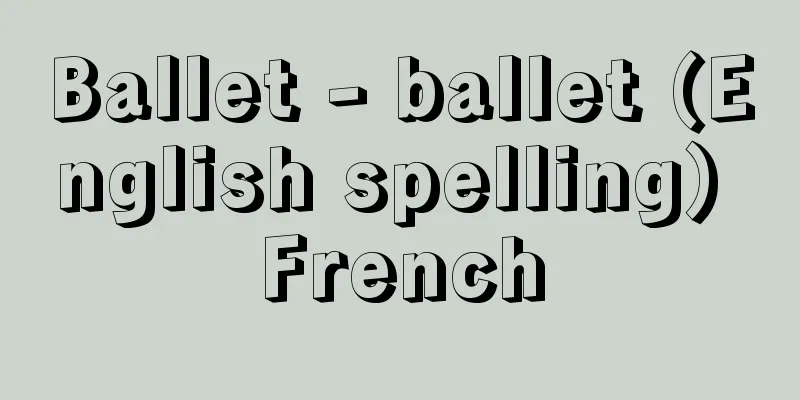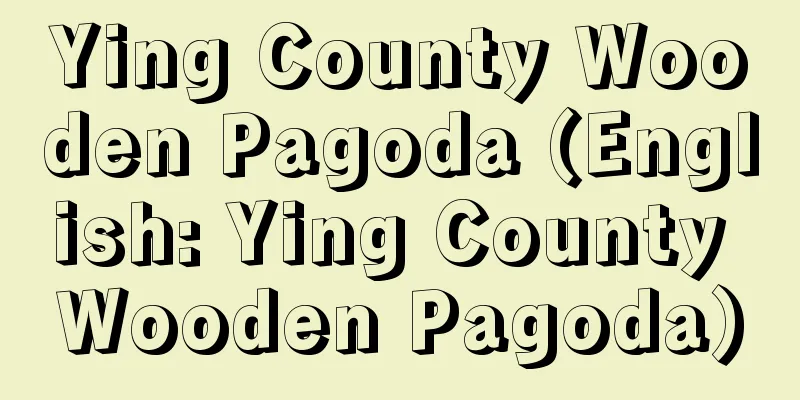Ballet - ballet (English spelling) French

|
Ballet is a type of dance form that developed in Europe, and is a comprehensive art form that includes music, mime (past drama), costumes, and sets. As its name derives from the Italian word ballare (to dance), it was born in the Italian courts during the Renaissance (14th to 16th centuries). Compared to other dances, ballet is characterized by the principle of spreading the legs apart, and by strictly determined patterns for walking, jumping, and spinning steps. Since it places more importance on the expression of the feet than on the upper body, it is also said to be a dance of hunter-gatherers. [Masa Ichikawa] History of BalletFrom court ballet to theatre balletBallet began as entertainment at banquets in the Italian Renaissance court. During the heyday of the Medici family, it was customary to entertain guests with a variety of carefully constructed performances during banquets that lasted five or six hours. First, there was an entrance called the entrée, in which nobles and their wives entered the great hall. Men and women lined up in pairs, bowed to each other, and walked while dancing hand in hand. The path of this dance was called the cheman, and a walking pattern was drawn on the floor or shown to the dancers in advance. It is said that ballet was created based on the way of greeting at court, and the entrée procession was also based on the manner of etiquette between men and women. In this way, in early ballets, nobles only danced and marched in the entrée scene, but as dancers became more specialized, dancers participating in the entrée began to dress up as characters. For example, in 17th century ballets depicting the heavens, dancers dressed up as mist, hail, thunder, shooting stars, etc. The Italian court festivities were transferred to the court of Paris when the Medici daughter Caterina (Catherine de Medici in France) became queen of France's Henry II, and became even more extravagant. The first recorded work in ballet history was the Ballet Comique de la Reine, performed at the Palais du Petit-Bourbon in Paris in 1581. It was held to celebrate the marriage of Duke Johayeuse to Margaret (Marguerite), sister of Queen Louise de Lorraine, and the libretto and choreography were by Balthazar de Beaujoailles, a musician employed by Catherine de Medici. The story is based on a Greek myth about water and sea nymphs who are bewitched by the witch Circe and then freed by Jupiter, and shows Baroque characteristics such as a jumble of grotesques, loss of substance through successive transformations, duality of characters, and the intermingling of heaven and earth. This particular form of transformation was unique to Baroque theater, and Baroque theater is also known as court ballet. French court ballet continued to flourish, and professional dancers began to appear during the reign of Louis XIV, when Lully and Molière were writing music and librettos. In 1661, the Royal Academy of Dance was founded, with Beauchamp as its full-time teacher. The five basic foot positions for ballet were established, and the Academy was merged with the Academie des Musicaux, founded in 1669, to form the Royal Academy of Music and Dance (now the Paris Opera) in 1672. Ballet began as entertainment at banquets, but the nature of ballet at the time of its creation has cast a large shadow over the development of ballet thereafter, determining its content, as can be seen in subsequent grand ballets such as Swan Lake and Sleeping Beauty, in which a man and a woman are united in love in the final act, and in other acts featuring a duet of entertainment dances known as divertissement. [Masa Ichikawa] From Romantic Ballet to Classical BalletEuropean ballet in the 18th century was developed mainly at the Paris Opera, and dancers such as Marie Camargo and Marie Salle, and choreographers such as Beauchamp and Nover were active. In the 19th century, the romanticism that swept across Europe also penetrated the world of ballet, ushering in the most uplifting period in ballet history. Among them, the poet Gautier was also active as a dance critic and the librettist of "Giselle." He said, "The Opera was entrusted to fantastical and mysterious beings such as the nymphs of the earth, the water, the fire, the nymphs, Nix, Willy, and Peri, and the 12 temples of Olympus, made of marble and gold, were banished to the warehouse." Witches and people wearing Greek-style tunics disappeared, and folk traditions from various parts of Europe became the theme, and the dancers who appeared wore thin satin skirts and appeared on stage as fairies with wildflower crowns on their heads. Many works from the Romantic period feature fairies, such as "La Sylphide" and "Giselle." These works include dreamy mysticism, nostalgia for faraway countries and a legendary past, and a love of folklore. Sylphide is an air spirit, and Willie, who appears in "Giselle," is a fairy that is a mixture of air and forest. Other works that were performed include "La Péri" and "Ondine." A typical romantic ballet work is composed of two acts. For example, in "Giselle," the first act is a lively scene of peasant life that unfolds in the village square, and the second act is a completely different, fantastical scene. It was during this period that pointe shoes were first used. If the theme was a fairy world, the dancers had to appear to be floating. Pointe shoes made this possible, and when the dancers walked across the stage in a pas de bourrée, it looked as if their feet were not touching the floor. Marie Taglioni in particular was described by Gautier as "resembling a happy soul walking on rosy tiptoes over heavenly flowers, without bending the petals," and was a dancer who embodied the heavenly nature of Romantic ballet. On the other hand, Austrian-born Fanny Elssler embodied an earthly nature. She was an accomplished dancer, specializing in Spanish cachuchas and Polish folk dances, and was a dancer suited to the exoticism of Romantic ballet. It is said that at the time, audiences were divided into two factions, the Taglioni faction and the Elssler faction, which fought over each other. Other dancers who were active in the field included Carlotta Grisi, who danced Giselle, her husband Jules Perrot, Fanny Cerrito (1817-1909), known as the other Fanny, and Lucile Grahn (1819-1907) of Denmark. After Romantic ballet, European ballet declined, male dancers became few and far between, and few works from this period remain today, such as Coppélia (1870) and Sylvia (1876). Meanwhile, Russia, a country that was a developing country in ballet, invited Petipa and Cecchetti to perform grand ballets such as The Sleeping Beauty (1890) choreographed by Petipa, The Nutcracker (1892) choreographed by Ivanov, and Swan Lake (1895) choreographed jointly by Petipa and Ivanov, using music by the genius ballet composer Tchaikovsky. These spectacular ballets, with many acts and scenes, rich storylines, and which were perfected in Russia in the late 19th century, came to be called classical ballet. [Masa Ichikawa] 20th century balletRussian BalletIn Russia, in addition to the accumulated knowledge from the end of the 19th century, there was a strong desire to reform the old system. Diaghilev was the central figure, and together with painters Nikolai Konstantinovich Rerikh (1874-1947), L. Bakst, and Benoit Alexandre Benois (1870-1960), he edited the magazine "World of Art" to introduce Russian art and music to Europe, and in 1909 he founded the Russian Ballet (Ballets Russes) in Paris, where it held its debut performance. Among the musicians who participated were Prokofiev and Stravinsky, the choreographer Fokine, and the dancers Nijinsky, Pavlova, and Karsavina. Fokine was inspired by Isadora Duncan's dancing and attempted to reform ballet, emphasizing an expressive form that was in line with the theme. The activities of the Russian Ballet can be divided into two periods, the first of which was characterized by barbarism and exoticism. The Polovtsian Dance from Prince Igor is a dance consisting of vigorous leaps that show off the wildness of the Slavs, and Nijinsky's choreography of The Rite of Spring also dealt with the folkloric ritual of human sacrifice, leaving an overwhelming impression on the audience. Fokine's Scheherazade is a representative work of exoticism, with Bakst's costumes and sets using primary colors, Rimsky-Korsakov's music that stirs up dreams of the East, Ida Rubinstein's (1885-1960) sensual body, and Nijinsky's beast-like golden slave, making for an extremely fascinating stage performance. Fokine's Firebird, Petrushka, and The Fairy of the Rose are also representative works from this period. From the late 1910s, Diaghilev began to employ not only Russian artists but also artists living in Paris, and at the same time, he moved away from the Russian culture and approached experimental modern art. For example, in his machine-choreographed Parade (1917), he employed Satie for music and Picasso for art, and Satie's music, which was composed of Picasso's cubist devices and concrete sounds such as the sound of a typewriter, is said to have stunned the audience. The Russian Ballet was dissolved in 1929 with Diaghilev's death, but in the latter half of the period, choreographers such as Balanchine and dancers such as Lifar and Danilova were active. The Prodigal Son (1929), which is still in the repertoire of the New York City Ballet, premiered with Balanchine's choreography and Lifar in the lead role. [Masa Ichikawa] Ballets from around EuropeIn England, de Valois founded the Big Wells Ballet (now the Royal Ballet) in 1931, and with the help of Nikolai Sergeev (1876-1951), who defected from the Soviet Union at the time, added Giselle and Swan Lake to the repertoire. Until then, British ballet had lost the protection of the royal court due to the Victorian morality that considered eroticism evil, and survived in music halls. De Valois used Fontaine as prima ballerina and performed Ondine (1958), choreographed by Ashton. After de Valois, the Royal Ballet's artistic directors were Ashton, MacMillan, Anthony Dowell (1943- ), and Ross Stretton (1952-2005). Other active companies include the Rambert Dance Company (then known as Ballet Rambert), which premiered Tudor's Lilac Garden (1936) and the English National Ballet (originally the London Festival Ballet), founded by Dolin and Markova in 1950. In Denmark, the Royal Danish Ballet, founded in 1748, has inherited the legacy of the Romantic ballet era, such as Naples (1842) by the famous choreographer Bournonville, and has contributed to modern ballet in a unique way. Harald Lander (1905-1971), who created Etudes (1952), and the outstanding male dancer Eric Bruhn (1928-1986) were also from Denmark, and Denmark has produced many talented male dancers, including Peter Martins (1946-) of the New York City Ballet and Helgi Tomasson (1942-) of the San Francisco Ballet. The Royal Swedish Ballet also boasts a long tradition dating back to the 18th century. In France, after the dissolution of Diaghilev's Ballets Russes, the remnants of the company formed the Ballets Russes de Monte Carlo and the Ballets de Cuevas, which performed works by Massine, David Lichine (1910-1972), and Fokine, with dancers such as Danilova. The Paris Opera revived the lyricism that had long been banished, with Olga Alexandrovna Spessivtseva (1895-1991) dancing Giselle, and in 1929 invited Lifar, who had been a member of the Ballets Russes, to become ballet master in an attempt to revive it. Lifar choreographed and performed works such as Suite in White (1943), and trained dancers such as Lycette Darsonval (1912-1996) and Chaubilet. Lifar's successors as artistic directors were George Skibine (1920-1981) and Michel Descombey (1930-2011), followed by Nureyev, Dupont, and Brigitte Lefèvre (1944-). Outside of the Opera, Roland Petit, who founded the Champs-Élysées Ballets in 1944 and has led the Marseille Ballets since 1972, has attracted attention and is well known for his witty works such as "Carmen," "Coppelia," and "Notre Dame de Paris." Yet another talented director was Béjart, who led the Ballet Theatre de Paris in Paris in 1957, the Royal Ballet of the 20th Century in Belgium from 1960, and the Béjart Ballet Lausanne in Switzerland in 1987. He showed enthusiasm for ballet works as total theater, and showed his talent in directing works such as "Romeo and Juliet," "Nijinsky, the Divine Clown," and "Kabuki." Germany aimed to move away from being a backward country in terms of ballet, but even in the 20th century, there was nothing that drew attention. On the contrary, it is a country of modern dance along with the United States, and the Neue Tanz (New Dance) movement was active from the 1920s to World War II. However, after the British dancer Cranko became artistic director of the Stuttgart Ballet in 1961, it began to attract worldwide attention. His works include Onegin and The Taming of the Shrew. After his death, Marcia Haydée (1939-) and Reid Anderson (1949-) led the same company. The Hamburg Ballet is led by American choreographer J. Neumeier, and W. Forsythe presents innovative works at the Frankfurt Ballet. Furthermore, choreographer J. Kylian of the Netherlands Dans Theater (established in 1955), currently the most prominent in the European ballet world, is a student of Cranko and is said to be a talented person who surpasses Béjart. He is good at fast developments and has produced works such as "Symphony in D" and "Marriage". [Masa Ichikawa] Russian BalletDuring the revolutionary period in Russia, several new attempts were made. Kasyan Goleizovsky (1892-1970), who was Balanchine's teacher, tried to create a more folk-oriented ballet by incorporating elements of acrobatics and vaudeville. After the revolution, many works were produced that conformed to socialist realism, as seen in The Red Poppy (1927), choreographed by Vasily Dmitrievich Tikhomirov (1876-1956) of the Bolshoi Ballet, and the tendency towards realistic ballet, borrowing the form of grand ballet, became stronger. Excellent dancers were also produced, and lyrical ballerinas such as Dodinskaya and Ulanova came out of the pupils of Vaganova, who taught at the Mariinsky Theatre in St. Petersburg. Representative works of socialist realism include Flames of Paris by Vasily Ivanovich Vainonen (1901-1964), Fountain of Bakhchisarai by Rostislav Vladimirovich Zakharov (1907-1984), Romeo and Juliet by Leonid Lavrovsky (1905-1967), and Spartacus by Grigorovich. After World War II, several dancers defected to the West, among them Nureyev, Natalia Makarova (1940-), and Barishnikov. Dancers active in Russia since the collapse of the Soviet Union include Plisetskaya, Irina Aleksandrovna Kolpakova (1933- ), Ekaterina Maximova (1939-2009), Natalia Bessmertnova (1941-2008), Nina Ananiashvili (1963- ), Andrei Uvarov (1971- ), and I. Vyatkina. [Masa Ichikawa] American BalletThe history of ballet in America is not long, but it developed rapidly from the 1930s onwards, and continues to this day. There are two major trends. The first was Ballet Theatre (later renamed American Ballet Theatre), founded in 1939, which staged ambitious works such as Tudor's "Lila Garden," "Pillar of Fire," and "Dark Elegy," DeMille's "Fall River Story," and Robbins' "Fancy Free." The artistic director from 1980 to 1989 was Barishnikov, who was from the former Soviet Union (now Latvia), and he actively added not only classical ballets such as "Don Quixote," but also modern dance works by Twyla Tharp (1941-) to the repertoire. Meanwhile, the New York City Ballet was founded in 1933 as the School of American Ballet, which Balanchine established in cooperation with Lincoln Kirstein (1907-1996) after moving to the United States. Graduates from the school went on to form the American Ballet Company, Ballet Caravan, and Ballet Society, before developing into the current company in 1948. Most of the works were Balanchine's, and many of them were abstract pieces with a combination of steps known as neoclassicism, such as "Serenade" and "Concerto Barocco." Robbins is famous for choreographing the musical "West Side Story," but he also presented works such as "The Cage," "Marriage," and "Dances at the Gathering" with the company, and was proactive in using unexpected direction and folk dance and jazz. Generally speaking, the qualitative difference between ballet and modern dance has almost disappeared in contemporary American and European ballet. For example, T. Tharp and K. Armitage have a background in modern dance but have produced works that could be considered ballet, while Béjart and J. Kylian have created works in which the dancers dance without ballet shoes. Neumeier of the Hamburg Ballet and Forsythe of the Frankfurt Ballet also have a background in modern dance, and the French dancer Maguy Marin (1951-) has choreographed works such as Cinderella for the Lyon Ballet. [Masa Ichikawa] Japanese BalletThe history of ballet in Japan began in 1912 (Taisho 1), when Italian G. V. Rosi, who inherited the Cecchetti method, was invited to the newly established Imperial Theater to teach ballet to its in-house actors. His students included Ishii Baku, Takada Masao (1895-1929), and Takada Seiko. Also, Takagi Tokuko (1891-1919), who had returned from the United States, was the first Japanese to dance toe dance, which was a novelty. In the 1920s, the virtuoso Anna Pavlova came to Japan with her ballet company, and her dance of The Dying Swan (choreographed by Fokine) was highly praised, teaching the beauty of ballet to the Japanese people. Later, the Pavlova sisters (Eliana Pavlova (1899-1941) and Nadezhda Pavlova (?-1982)), who were Russian refugees, established a studio in Kamakura, and among their students were Hattori Chieko, Azuma Yusaku, Tachibana Akiko, Kaitani Yaoko, and Shimada Hiroshi (1919-2013). Another Russian, Olga Sapphire (1912-1981), also came to Japan in 1936 (Showa 11) and taught at the Nichigeki Theater, mentoring Matsuo Akemi (1918-2013) and Matsuyama Mikiko, among others. After the Second World War, Japanese ballet blossomed in earnest, and as early as 1946, the Tokyo Ballet was formed through a joint venture of various ballet companies, and "Swan Lake" was premiered with choreography by Masahide Komaki, who had returned from abroad. Since then, many ballet companies were formed, including the Komaki Ballet, the Hattori-Shimada Ballet, the Momoko Tani Ballet, and the Haruhi Yokoyama Ballet, each continuing their own activities. In addition to imitating foreign ballets and respecting the classics, there was also a growing desire to create original works, and excellent choreographers such as Naoto Seki (1929-2019), Shigeru Yokoi (1930-2017), and Takeshi Takahashi were born. As for dancers, Yoko Morishita Yoko, who won the gold medal at the Varna International Dance Competition in Bulgaria, was active internationally, including as a guest performer at the American Ballet Theatre, impressing the world with the growth of Japanese ballet. Currently, in addition to the Matsuyama Ballet Company to which Morishita belongs, the Asami Maki Ballet Company and the Tchaikovsky Memorial Tokyo Ballet are also actively involved. [Masa Ichikawa] "Basic Knowledge of Ballet" by Ashihara Eiryo (1950, Sogensha) ▽ "Ballet - Form and Symbolism" by G. Zacharias, translated by Watanabe Ko (1965, Bijutsu Shuppansha) ▽ "Classical Ballet: Basic Terms and Techniques" by Kirsten et al., translated by Matsumoto Ryo and Mori Ken (1967, Ongaku No Tomosha) ▽ "The History of Ballet" by F. Reyna, translated by Ogura Shigeo (1974, Ongaku No Tomosha) ▽ "The World of Ballet" by O. Joyeux, translated by Otsu Toshikatsu (1980, Bookmansha) ▽ "Ballet and Modern Dance - Their History" by Anderson, Jacques, translated by Yukawa Kyoko (1993, Ongaku No Tomosha) ▽ "The Golden Age of Russian Ballet" by Nozaki Yoshio (1993, Shinshokan) ▽ "The 20th Century of Dance" by Ichikawa Masa (1995, Shinshokan) ▽ "Ballet - A History from Its Birth to the Present" by Usui Kenji (1999, Ongaku No Tomo Sha) ▽ "The Unknown History of Russian Ballet" by Murayama Kumiko, planned and edited by the Eurasia Booklet Editorial Committee (2001, Toyo Shuppan) ▽ "Invitation to Ballet" by Suzuki Akira (2002, Chikuma Shobo) ▽ "The Birth of Ballet" by Suzuki Akira (2002, Shinshokan) ▽ "The History of Ballet" by M.F. Christou, translated by Sato Toshiko (Hakusuisha, Quessais-je Bunko) [References] | | | | | | | | | | | | | | | | | | | | | | | | | | | | | | | | | | | | | | | | | | | | | | | | | | | | | | | | | | | | | | | | | | | |Source: Shogakukan Encyclopedia Nipponica About Encyclopedia Nipponica Information | Legend |
|
バレエはヨーロッパに発達した舞踊形式の一種で、音楽、マイム(黙劇)、衣装、装置などを伴う総合芸術である。イタリア語のballare(踊る)を語源とするように、ルネサンス期(14~16世紀)のイタリアの宮廷に生まれた。他の舞踊に比較して足を開くことを原則とし、歩く、跳ぶ、回るステップなど厳密にパターンが決められているのを特色とする。足の表現を上半身のそれよりも重視しているところから、狩猟民族系の舞踊ともいわれている。 [市川 雅] バレエの歴史宮廷バレエから劇場バレエへバレエはイタリア・ルネサンス期の宮廷における祝宴の余興から始まった。メディチ家の盛時には、5、6時間の祝宴中、入念に構成されたさまざまな出し物で賓客をもてなすのが習慣であった。まずアントレという入場があり、貴族とその夫人たちが大広間に入ってくる。男女は列をつくるとともに一対になって、互いにおじぎをし、手を取り合って踊りながら歩く。この踊りの道筋をシェマンといい、床に歩くための図形が描かれるか、まえもって踊る人々に示されていた。バレエは宮廷における挨拶(あいさつ)の仕方をもとにつくられたといわれ、このアントレの行進も男女の礼儀のあり方を基本にしている。このように初期のバレエでは貴族たちがアントレの場面で踊りながら行進するだけだったが、踊り手が専門化するにつれて、アントレに参加する踊り手は登場人物の扮装(ふんそう)をするようになった。たとえば17世紀における天上界を描くバレエでは、霧、霰(あられ)、雷、流星などに扮していた。 イタリアでの宮廷の祝宴は、メディチ家の娘カテリーナ(フランスではカトリーヌ・ド・メディシス)がフランスのアンリ2世の王妃となるとともにパリの宮廷に移され、より豪華なものになっていった。1581年のパリのプチ・ブルボン宮で上演された『王妃のバレエ・コミック』はバレエ史上記録に残る最初の作品である。ジョアイユーズ公爵と王妃ルイーズ・ド・ロレーヌの妹マルガレーテ(マルグリット)の結婚を祝って催され、台本と振付けはバルタザール・ド・ボジョアイユで、カトリーヌ・ド・メディシスが雇った音楽家であった。内容は、魔女キルケの魔法にかけられた水の精、海の精たちがユピテルによって解放されるというギリシア神話によるもので、グロテスクのごった返し、変身に次ぐ変身による実体の喪失、登場人物の二重性、天と地との交錯などバロック的特徴を示している。とくにこの変身のあり方はバロック演劇特有のもので、バロック演劇は宮廷バレエの別称ともなっている。 フランスの宮廷バレエはその後も繁栄を続け、ルイ14世時代、リュリやモリエールらが音楽や台本を書くころには、職業的な踊り手が出現するようになった。1661年、王立舞踊アカデミーが創設され、ボーシャンが専任教師となって、バレエの基本である足の五つのポジションが定められ、1669年設立の音楽アカデミーと合体して1672年に王立音楽舞踊アカデミー(現在のパリ・オペラ座)の設立をみるに至った。 バレエは祝宴の余興から始まったが、その後のグランド・バレエ『白鳥の湖』や『眠れる森の美女』などの終幕では男女が愛によって結ばれ、他の幕ではディベルティスマンといわれる余興の踊りの競演がみられるように、発生時に与えられた性質は以後のバレエの展開に大きな影を落とし、その内容を決定づけている。 [市川 雅] ロマンチック・バレエから古典バレエへ18世紀のヨーロッパのバレエは、パリ・オペラ座を中心に展開され、マリー・カマルゴ、マリー・サレなどの舞踊家、ボーシャン、ノベールなどの振付師が活躍した。19世紀になると、ヨーロッパを席巻(せっけん)したロマン主義精神がバレエの世界にも入り込み、バレエ史上もっとも高揚した時代を迎えた。なかでも詩人ゴーチエは舞踊評論家としても活躍し、『ジゼル』の台本作家でもあった。彼は「地の精、水の精、火の精、小妖精(ようせい)、ニクス、ウィリー、ペリなど幻想的な神秘的な存在にオペラ座はゆだねられ、オリンポスの大理石と黄金の12の神殿は倉庫の中に追放された」と語っている。魔女やギリシア風のチュニックを着けた人物は消えて、ヨーロッパの地方の民俗的伝承が主題となり、登場する舞姫は薄いサテンのスカートを着け、妖精となって野の花の冠を頭に飾り舞台に現れた。 ロマン主義時代の作品には、『ラ・シルフィード』『ジゼル』など妖精が出てくるものが多い。夢想的な神秘主義、はるかなる国々、伝説的な過去への郷愁、民間伝承の愛好などがここにはみられる。シルフィードは空気の精であり、『ジゼル』に登場するウィリーは空気と森の混合した妖精である。そのほかにも『ラ・ペリ』『オンディーヌ』などが上演されている。ロマンチック・バレエの典型的な作品は2幕構成になっていて、たとえば『ジゼル』のように、第1幕は村の広場で展開される生き生きとした農民の生活場面であり、第2幕はがらりと変わって幻想的な場面である。 この時代には、トーシューズが初めて用いられるようになった。主題が妖精の世界ならば、舞姫たちは浮遊して見えなければならない。それを可能にしたのがトーシューズで、舞姫たちがパ・ド・ブーレで舞台を歩くと、床に足をつけていないように見えたという。とくにマリー・タリオーニは、ゴーチエによれば「天国の花の上を花びらをたわめることなく、バラ色のつまさきで歩く幸福な魂に似ている」とされ、ロマンチック・バレエの天上的性質を具現するダンサーであった。 一方、オーストリア生まれのファニー・エルスラーは地上的性質を体現した。彼女はスペインのカチューチャやポーランドの民族舞踊などを得意とし、ロマンチック・バレエの異国趣味に見合った踊り手であった。当時、観客はタリオーニ派とエルスラー派の二つに分かれて争ったといわれる。このほか、『ジゼル』を踊ったカルロッタ・グリジ、その夫ジュールス・ペロー、もう一人のファニーといわれたファニー・チェリートFanny Cerrito(1817―1909)、デンマークのルシール・グラーンLucile Grahn(1819―1907)らが活躍した。 ロマンチック・バレエ以後、ヨーロッパのバレエは衰退し、男性舞踊手は数少なくなり、現在残っているこの時代の作品は『コッペリア』(1870)、『シルビア』(1876)など多くない。一方、バレエの後進国であったロシアでは、プチパやチェケッティらを招待し、天才バレエ音楽作曲家チャイコフスキーの音楽を使って、プチパ振付けのグランド・バレエ『眠れる森の美女』(1890)、イワーノフ振付けの『くるみ割り人形』(1892)、プチパとイワーノフ共同振付けの『白鳥の湖』(1895)などを上演した。これら19世紀後半ロシアで完成された、幕と場数の多いストーリー性の濃い、スペクタクル様式のバレエを古典バレエとよぶようになった。 [市川 雅] 20世紀のバレエロシア・バレエ団ロシアでは、19世紀末の蓄積に加えて、古い体質を改革しようとする意欲がみなぎっていた。ディアギレフはその中心的人物で、レーリッヒNikolai Konstantinovich Rerikh(1874―1947)、L・バクスト、ブノワAlexandre Benois(1870―1960)らの画家と雑誌『芸術の世界』を編集して、ロシアの美術・音楽をヨーロッパに紹介するとともに、1909年、パリでロシア・バレエ団(バレエ・リュス)を設立、デビュー公演を行った。音楽家としてプロコフィエフ、ストラビンスキー、振付家としてフォーキン、舞踊手としてニジンスキー、パブロワ、カルサビナらがこれに参加した。フォーキンはイサドラ・ダンカンの踊りに刺激されてバレエの変革を企て、主題に沿った表現形式を重視する立場をとった。ロシア・バレエ団の活動は2期に分けられるが、前期はバーバリズムとエキゾチシズムに特徴があった。『イーゴリ公』の「ダッタン(ポロビッツ)人の踊り」はスラブの野性を誇示する激しい跳躍からなる舞踊であり、ニジンスキー振付けの『春の祭典』も民間伝承の人身御供(ごくう)の儀式を扱い、観客に圧倒的な印象を与えた。フォーキン振付けの『シェヘラザード』は、エキゾチシズムの代表的作品であり、原色を使ったバクストの装置・衣装、東方への夢をかき立てるリムスキー・コルサコフの音楽、ルビンシテインIda Rubinstein(1885―1960)の官能的な肉体、そしてニジンスキーの演じる野獣のような金(きん)の奴隷など、きわめて魅力的な舞台であった。『火の鳥』『ペトルーシュカ』『バラの精』も、このころのフォーキンの代表作である。 ディアギレフは1910年代後半から、ロシア人だけでなく、パリに住む芸術家を登用するようになり、それとともにロシアの風土性から離れ、実験的な現代芸術へ接近していった。たとえば、マシーン振付けの『パラード』(1917)では音楽にサティ、美術にピカソを起用し、ピカソによるキュビスムの装置とタイプライターの音など具体音で構成されたサティの音楽は、観客のど肝を抜いたといわれる。ロシア・バレエ団は1929年、ディアギレフの死によって解散したが、その後半は、振付家としてバランチン、舞踊家としてリファール、ダニロワなどが活躍した。現在でもニューヨーク・シティ・バレエ団のレパートリーに入っている『放蕩(ほうとう)息子』(1929)は、バランチンの振付け、リファールの主役で初演されている。 [市川 雅] ヨーロッパ各国のバレエイギリスでは、1931年、ド・バロアがビッグ・ウェルズ・バレエ団(現在のロイヤル・バレエ団)を創設し、当時のソ連から亡命したニコライ・セルゲーエフNikolay Sergeev(1876―1951)の助けを得て『ジゼル』『白鳥の湖』をレパートリーに加えた。それまでのイギリスのバレエは、エロティシズムを悪とするビクトリア王朝の道徳観のために宮廷の保護を失い、ミュージック・ホールで生き延びていた。ド・バロアはフォンティンをプリマ・バレリーナに使い、アシュトン振付けの『オンディーヌ』(1958)などを上演した。ド・バロアののち、ロイヤル・バレエ団の芸術監督はアシュトン、マクミラン、ダウエルAnthony Dowell(1943― )、ストレトンRoss Stretton(1952―2005)らが就任した。このほか、チューダーの『リラの園』(1936)などを初演したランベール・ダンス・カンパニー(当時はバレエ・ランベール)、ドーリンとマルコワが1950年に設立したイングリッシュ・ナショナル・バレエ団(当初はロンドン・フェスティバル・バレエ団)などが活動している。 デンマークでは、1748年発足のデンマーク王立バレエ団がロマンチック・バレエ時代の名振付家ブルノンビルの『ナポリ』(1842)などの遺産を引き継ぎ、じみながら現代のバレエに貢献している。『エチュード』(1952)をつくったランダーHarald Lander(1905―1971)、優れた男性舞踊手ブリューンEric Bruhn(1928―1986)らもデンマーク出身であり、ニューヨーク・シティ・バレエ団のマーチンスPeter Martins(1946― )、サンフランシスコ・バレエ団のトマソンHelgi Tomasson(1942― )など、とくに男性舞踊手に優秀な人材を出している。なお、スウェーデン王立バレエ団も18世紀以来の長い伝統を誇っている。 フランスでは、ディアギレフのロシア・バレエ団の解散後、残党組がモンテカルロ・ロシア・バレエ団(バレエ・リュス・ド・モンテカルロ)やバレエ・ド・クエバスなどを組織し、マシーン、リシンDavid Lichine(1910―1972)、フォーキンの作品などを上演し、舞踊手にはダニロワらが参加した。パリ・オペラ座は、スペシフツェワOlga Alexandrovna Spessivtseva(1895―1991)の踊る『ジゼル』などで長い間追放されていたリリシズムを復活し、1929年にはロシア・バレエ団に在籍していたリファールをバレエ・マスターに招いて再興を図った。リファールは『白の組曲』(1943)などを振付け、上演し、ダルソンバルLycette Darsonval(1912―1996)、ショビレらの舞踊手を育てた。リファールの後継者としてスキビーヌGeorge Skibine(1920―1981)、デコンビーMichel Descombey(1930―2011)が芸術監督になり、その後はヌレーエフ、デュポン、ルフェーブルBrigitte Lefèvre(1944― )と続く。オペラ座以外では、1944年シャンゼリゼ・バレエ団を結成し、1972年からマルセイユ・バレエ団を率いるローラン・プチが注目され、『カルメン』『コッペリア』『ノートル・ダム・ド・パリ』などエスプリのきいた作品には定評がある。 さらにもう一人の俊才は、1957年にパリでバレエ・シアター・ド・パリ、1960年からベルギーの王立二十世紀バレエ団、1987年からスイス、ローザンヌに移り、ベジャール・バレエ・ローザンヌを率いるベジャールである。彼はトータル・シアター(全体演劇)としてのバレエ作品に意欲を示し、『ロメオとジュリエット』『ニジンスキー・神の道化』『カブキ』などの演出に才気をみせた。 ドイツでは、バレエ後進国からの離脱を目ざしたが、20世紀になってからも注目されるようなものはなかった。むしろアメリカと並びモダン・ダンスの国で、1920年代から第二次世界大戦までノイエ・タンツ(新舞踊)の運動が活発であった。しかし、1961年にイギリス人クランコがシュトゥットガルト・バレエ団の芸術監督になって以後、世界の注目を集めるようになった。彼の作品には『オネーギン』『じゃじゃ馬馴(な)らし』などがある。彼の死後、ハイデMarcia Haydée(1939― )、アンダーソンReid Anderson(1949― )が同バレエ団を率いている。またハンブルク・バレエ団はアメリカ人の振付家J・ノイマイヤーが率いており、フランクフルト・バレエ団ではW・フォーサイスが革新的な作品を発表している。 なお現在ヨーロッパのバレエ界でもっとも注目されているオランダのネザーランド・ダンス・シアター(1955発足)の振付家J・キリアンはクランコ門下で、ベジャールを超える逸材ともいわれる。スピードのある展開を得意とし、『シンフォニー・イン・D』『結婚』などの作品がある。 [市川 雅] ロシアのバレエ革命期のロシアでは新しい試みがいくつかなされた。バランチンの師にあたるゴレイゾフスキーKasyan Goleizovsky(1892―1970)は曲技やボードビルなどの要素を取り入れ、より民衆的なバレエをつくろうとした。革命後は、ボリショイ・バレエ団のチホミーロフVasily Dmitrievich Tikhomirov(1876―1956)振付け『赤いけし』(1927)にみられるように、社会主義リアリズムに準拠した作品が多くなり、グランド・バレエの形式を借りた写実的な傾向が強まった。踊り手にも優れた人材を輩出し、とくにサンクト・ペテルブルグのマリンスキー劇場で教えていたワガーノワの門下から、ドジンスカヤ、ウラーノワなど叙情的なバレリーナが出た。社会主義リアリズムの代表作として、ワイノーネンVasily Ivanovich Vainonen(1901―1964)の『パリの焔(ほのお)』、ザハロフRostislav Vladimirovich Zakharov(1907―1984)の『バフチサライの泉』、ラブロフスキーLeonid Lavrovsky(1905―1967)の『ロメオとジュリエット』、グリゴロービチの『スパルタクス』などがある。第二次世界大戦後、何人かのダンサーが西側に亡命したが、なかでもヌレーエフ、マカロワNatalia Makarova(1940― )、バリシニコフの存在は大きい。ソ連崩壊後のロシアで活躍しているダンサーには、プリセツカヤ、コルパコワIrina Aleksandrovna Kolpakova(1933― )、マクシモワEkaterina Maximova(1939―2009)、ベスメルトノワNatalia Bessmertnova(1941―2008)、アナニアシビリNina Ananiashvili(1963― )、ウバーロフAndrei Uvarov(1971― )、I・ビャートキナらがいる。 [市川 雅] アメリカのバレエアメリカのバレエの歴史は古くはないが、1930年代に入って急速に発展し、今日に至っている。大きく二つの流れがあり、一つは1939年設立のバレエ・シアター(のちアメリカン・バレエ・シアターと改称)で、チューダーの『リラの園』『火の柱』『暗い悲歌』、デミルの『フォール・リバー物語』、ロビンズの『ファンシー・フリー』などの意欲的な作品を上演した。1980年~1989年の芸術監督は旧ソ連(現、ラトビア)出身のバリシニコフで、『ドン・キホーテ』などの古典バレエだけでなく、モダン・ダンスのサープTwyla Tharp(1941― )の作品などを積極的にレパートリーに加えた。 一方ニューヨーク・シティ・バレエ団は、アメリカに渡ったバランチンがカーステーンLincoln Kirstein(1907―1996)と協力して1933年に設立したアメリカン・バレエ学校を母体にしている。この卒業生によるアメリカン・バレエ団、バレエ・キャラバン、バレエ・ソサエティーを経て、1948年に現在のバレエ団に発展した。作品はバランチンのものが大半で、『セレナーデ』『コンチェルト・バロッコ』など、新古典主義といわれるステップの組合せによる抽象的な作品が多かった。ロビンズはミュージカル『ウェスト・サイド物語』の振付けで有名だが、『檻(おり)』『結婚』『ダンス・アット・ギャザリング』などの作品をこのバレエ団で発表しており、意表をつく演出と民族舞踊やジャズの採用にも積極的であった。 総じて、現代のアメリカ、ヨーロッパのバレエでは、バレエとモダン・ダンスの質的な差異はほとんどなくなっている。たとえば、T・サープやK・アーミタージュはモダン・ダンス出身だがバレエともいえる作品を発表しており、ベジャールやJ・キリアンはバレエ・シューズを着けずに踊る作品をつくっている。ハンブルク・バレエ団のノイマイヤー、フランクフルト・バレエ団のフォーサイスもモダン・ダンス出身であり、フランスのマランMaguy Marin(1951― )はリヨン・バレエ団のために『シンデレラ』などを振り付けている。 [市川 雅] 日本のバレエ日本のバレエの歴史は、チェケッティ・メソッドを継承するイタリア人G・V・ローシーが、1912年(大正1)新設まもない帝国劇場に招かれ、専属俳優にバレエの指導をした時に始まる。彼の弟子には石井漠(ばく)、高田雅夫(まさお)(1895―1929)、高田せい子らがいる。また、アメリカ帰りの高木徳子(とくこ)(1891―1919)が日本人として初めてトーダンスを踊り、珍しがられた。1920年代になると、名手アンナ・パブロワがバレエ団を率いて来日、とくに彼女の踊る『瀕死(ひんし)の白鳥』(フォーキン振付け)は絶賛を浴び、日本人にバレエの美しさを教えた。その後、亡命ロシア人のパブロワ姉妹(エリーナEliana Pavlova(1899―1941)・ナジェージダNadezhda Pavlova(?―1982))が鎌倉にスタジオを建て、その門下から服部智恵子(はっとりちえこ)、東(あずま)勇作、橘(たちばな)秋子、貝谷八百子(やおこ)、島田廣(ひろし)(1919―2013)らが輩出した。また、同じくロシア人サファイアOlga Sapphire(1912―1981)も1936年(昭和11)に来日して日劇で教え、松尾明美(あけみ)(1918―2013)、松山樹子(みきこ)らを育てた。 第二次世界大戦後、日本のバレエは本格的な開花期を迎え、早くも1946年(昭和21)には各バレエ団の合同により東京バレエ団が結成され、外国から帰った小牧正英(まさひで)の振付けで『白鳥の湖』が初演された。以後、小牧バレエ団、服部・島田バレエ団、谷桃子バレエ団、横山はるひバレエ団など多くのバレエ団が組織され、それぞれ独自の活動を続けた。また、外国のバレエの模倣や古典尊重だけでなく、オリジナルな作品をつくろうとする気運も高まり、関直人(なおと)(1929―2019)、横井茂(1930―2017)、高橋彪(ひょう)らの優れた振付家が生まれた。ダンサーでは、ブルガリアのバルナ国際舞踊コンクールで金賞を獲得した森下洋子が、アメリカン・バレエ・シアターに客演するなど国際的に活躍し、日本バレエの成長を世界に印象づけた。現在では、森下の所属する松山バレエ団のほか、牧阿佐美(あさみ)バレエ団、チャイコフスキー記念東京バレエ団などが精力的に活動している。 [市川 雅] 『蘆原英了著『バレエの基礎知識』(1950・創元社)』▽『G・ツァハリアス著、渡辺鴻訳『バレエ――形式と象徴』(1965・美術出版社)』▽『カースティンほか著、松本亮・森乾訳『クラシック・バレエ/基礎用語と技法』(1967・音楽之友社)』▽『F・レイナ著、小倉重夫訳『バレエの歴史』(1974・音楽之友社)』▽『O・ジョワイユ著、大津俊克訳『バレエの世界』(1980・ブックマン社)』▽『アンダソン、ジャック著、湯河京子訳『バレエとモダン・ダンス――その歴史』(1993・音楽之友社)』▽『野崎韶夫著『ロシア・バレエの黄金時代』(1993・新書館)』▽『市川雅著『ダンスの20世紀』(1995・新書館)』▽『薄井憲二著『バレエ――誕生から現代までの歴史』(1999・音楽之友社)』▽『村山久美子著、ユーラシア・ブックレット編集委員会企画・編『知られざるロシア・バレエ史』(2001・東洋出版)』▽『鈴木晶著『バレエへの招待』(2002・筑摩書房)』▽『鈴木晶著『バレエ誕生』(2002・新書館)』▽『M・F・クリストゥ著、佐藤俊子訳『バレエの歴史』(白水社・文庫クセジュ)』 [参照項目] | | | | | | | | | | | | | | | | | | | | | | | | | | | | | | | | | | | | | | | | | | | | | | | | | | | | | | | | | | | | | | | | | | | | | |出典 小学館 日本大百科全書(ニッポニカ)日本大百科全書(ニッポニカ)について 情報 | 凡例 |
<<: Ballet music - ballet music (English spelling)
>>: Pareidolia (English spelling)
Recommend
Nipponitella
...the largest species, such as the Permian Polyd...
Birmingham Canal Navigations
A general term for the canals around Birmingham in...
Abeno Shrine - Abenojinja
Located in Kitabatake, Abeno-ku, Osaka City. The ...
Lehen
...In other words, the vassal system, which was l...
Sigmund Freud
Austrian psychiatrist and founder of psychoanalys...
Yodogawa
The river flows out from the southern end of Lake...
Gyozai Kaishi - Gyozai Kaishi
…Although the name is different, it is the same b...
Yunnan Provincial Governor - Yunnan Provincial Governor
...From this point on, the term "Yunnan"...
Day, B. (English spelling) DayB
…(1) Characteristics of print media The first new...
Provisions restricting dismissal - Kaikoseigenkitei
...Due to these circumstances, there are various ...
Genus Cassia - Cassia genus
...The seeds are used in Chinese medicine as Wang...
"Autumn Diary" - Aki no Nikki
…In the 1930s, while teaching at a university, he...
Niccoli, N.
…That is, the Greeks continued to migrate to West...
Ady, E. (English spelling) AdyE
…Hungarian poet. Born in Ermindsen (now part of R...
L'homme armé (English spelling) Lhommearme
...The second type of cantus melody is part of th...



![Öland [island] - Öland](/upload/images/67cb0b041f693.webp)





